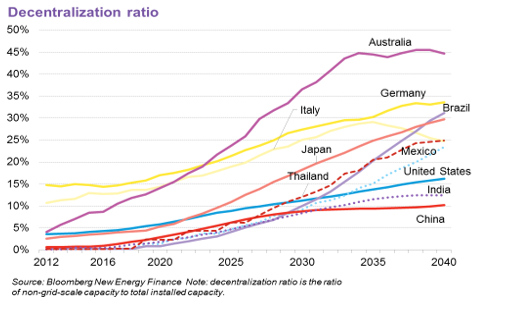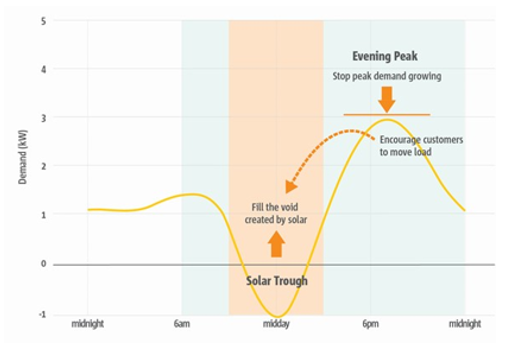Great Expectations for the Interactive Grid
Energy Networks Australia’s ‘Great Expectations – The Interactive Grid’ seminar explored the innovations and consideration needed as we move to an increasing number of household solar, battery storage and electric vehicles connecting to the grid.
The increase in the number of distributed energy resources (DER) presents both challenges and opportunities as networks seek to optimise the benefits of their integration for customers. Discussion at the seminar delved into questions of customer equity, incentivisation policy, electric vehicles (EVs), regulatory frameworks and distribution system operator design.
The line-up of speakers provided in-depth thinking on how networks are trying to navigate to a grid of the future, in the context of Australia being amongst the most decentralised energy systems in the world (as shown in figure 1). There are great expectations placed on network shoulders on how our future grid will be managed and optimised to be fit for purpose.

Figure 1: Bloomberg New Energy Finance note on decentralization ratio
Open Energy Networks update
An update on the progress of the Open Energy Networks project was provided by Dr Stuart Johnston from Energy Networks Australia and Violette Mouchaileh from the Australian Energy Market Operator. The update focussed on the required capabilities report that will be published in coming weeks.
The Open Energy Networks (OpEN) project is a joint initiative of Energy Networks Australia and AEMO and is looking at how best to transition to a two-way grid that allows better integration of DER to improve outcomes for all customers through the joint.
You can read more on the progress in Dr Johnston’s article this week: Solar saturation: sooner than we thought.
Are the same problems overseas?
No point spending the whole day talking about just Australia, with key lessons to be learnt from overseas experiences. The international keynote address was delivered by Professor Pierluigi Mancarella from the University of Manchester, UK. Pierluigi outlined key drivers that provide flexibility, security and reliability in market services and concluded that in future, superior flexibility can be harnessed through DER aggregation. This linked in the ongoing discussion for the day of the changing role of networks and customers as well as policy and regulators in navigating integration of DER into the grid.
Innovation in networks
Following the international keynote, the executive panel discussed the high desire for solar amongst customers and important parameters such as investment in information and communication capacity, optimisation beyond a technical envelope and right pricing to facilitate such a drive towards solar.
Discussion also highlighted that technological advancement, a flexible and adaptable regulatory structure and the investment has become necessary to ensure that our 20th century grid can support our 21st century expectations. In order to meet these expectations, we must rethink the design fundamentals and deliver the simplest possible solution that optimises the use of existing network capability.
Networks have invested in a wide range of innovative solutions to deal with the challenges the sector faces, many are documented in the Innovation in the Electricity Sector’ report released during the seminar. Some of these innovative studies in grid transformation and optimisation are being undertaken by networks, such as:
- Storage to support networks at peak times
- Customer engagement
- Voltage management
- Demand response management via smartphone app
- Stand-alone power systems
- Micro grid to improve power reliability and security
- Asset performance intelligence via quality assurance lab.
Safety and security
When designing the network of the future, we must also prioritise safety and security. To consider the implications of DER on security, the Australian Energy Market Commission is trialling innovative technologies, business products and models in a ‘regulatory sandbox’ before broader changes to regulation are explored. Non-network solutions / DER can contribute to efficient outcomes across the supply chain, and effectiveness of the regulatory framework relies on engagement in early network planning stage. Additionally, the Australian Energy Regulator is working on network tariff reform (as shown in Figure 2) to ensure consumers can choose to use the network in ways that maximise their lifestyle choices and that send efficient pricing signals to:
- Deliver efficient network investment to meet peak demand
- Encourage efficient take up of DER
- Drive service innovation to consumers (e.g. aggregation models)

Figure 2: The rational use of storage should result in reductions to peak demand and flatter load curves – driving efficient take up of DER
What does the Victorian Government think?
The Hon. Lily D’Ambrosio MP, Victorian Minister for Energy, Environment and Climate Change, spoke of the Victorian Government’s commitment to renewable energy generation targets of 50 per cent by 2030 through their Solar Homes Package.
The Victorian Government has also partnered with Jemena for a demand management project known as ‘Power Changers”, featured in the Innovation in the electricity sector report. Furthermore, the Victorian Government plans to lead the nation with the rollout of EV technology.
Electric vehicles
At the popular afternoon panel discussion, EVs – are networks ready?, Tritium mentioned that with faster chargers such as the HPC type (350 kW and can charge in 8 minutes for 320 km) coming into the market, additional constraints will be placed on the grid. Taking some learnings from the UK experience, EA Technology emphasised that innovative solutions are needed to cater for the rise in demand due to EVs (as shown in Figure 3). The proposed solutions were:
- significant stakeholder engagement
- increased network visibility via monitoring and modelling
- standardisation of smart charging.

Figure 3: Effect of additional EV demand – UK case study
What a day
To sum up the day: within the next few years, whole regions of Australia’s electricity system must be capable of operating securely, reliably and efficiently with a forecast of 100 per cent of instantaneous demand being met from DER in some areas within the next decade.
Speaker presentations from the seminar can be accessed here.


